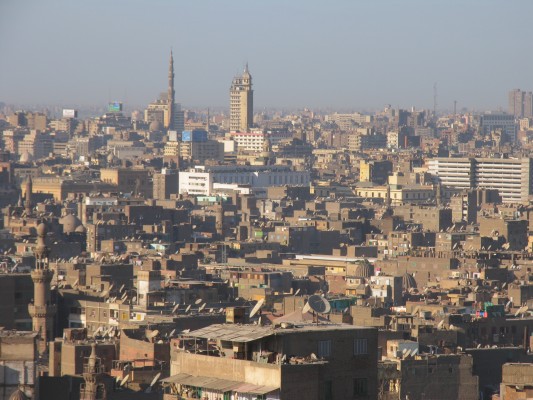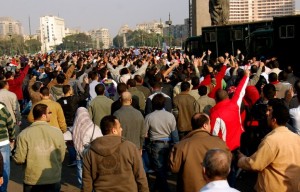
Unemployment isn’t working: the Arab Stabilization Plan and unemployment in the Middle East
The international community has recently seen the Greater Middle East go through one of its most tumultuous transitional periods since the Cold War. Through this period the world watched a wave of unrest sweep the populace, materializing in political uprisings in several states across the region. These uprisings have been characterized by widespread outcry for political stability, governmental reform, and a solution to the crippling unemployment crisis facing the Middle East.

Photo by Rowan El Shimi.
http://www.flickr.com/photos/rouelshimi/5411123952/. No changes were made to this image.
Though these movements brought hope of improvement, years later we still find the Middle East and North Africa in a perpetual cycle of political and economic instability. The current unemployment rate in the Middle East sits at 26.2% and 27.1% in Northern Africa, leaving 14-15 million people in the Middle East and North Africa (MENA) region looking for work. When focused on specific demographics, these numbers only worsen. The female unemployment in the region currently sits at a devastating in 42.6% in the Middle East, and 34.1% in North Africa. Pockets of youth joblessness reach as high as 60% in countries like Tunisia and Egypt.
These high levels of unemployment perpetuate political instability and economic stagnation, as regional governments lack the financial capacity to stimulate growth through their own resources. The high levels of risk and volatility in the region have caused investment, tourism, and private flows to freeze.
For the most part, this lack of economic stimulation continues unchecked. This causes governments to increase the spending levels of borrowed money, leading to further economic stagnation, higher deficits, and more infrastructural degradation.
The continuation of this crisis accompanies an increased risk to regional stability and global security, affecting millions of lives. Every day the economic and employment conditions continue to deteriorate, further increasing the risk of radicalization and civil violence. The Arab-British Chamber of Commerce hosted a conference at which King Abdullah II of Jordan spoke on the issue of unemployment in the Middle East. He stated that “Our young people coming out of school to face the worst unemployment rate of any region. Smart economic policy is critical to support inclusive, job-generating growth”.
The questions left unanswered, then, are how do we solve this crisis and alleviate the unemployment plaguing the region? How do we do it successfully, sustainably, and without increasing the risks of policy failure and radicalization?
Many job creation plans for the region are impossible to implement and fall victim to structural challenges that rack the economic stage in the Arab World. According to World Bank figures, a direct investment of US $100 billion could create up to 11 million jobs in 5 years.
Inspired by the European Recovery Plan (Marshall Plan) Majid H. Jafar, CEO of the Crescent Petroleum and Vice-chairman of the Crescent Group, created what he terms the Arab Stabilization Plan. This plan advocates an Arab-led implementation of this critical investment into infrastructure through private and public-private flows. The Arab Stabilization Plan will target Algeria, Egypt, Jordan, Libya, Morocco, Tunisia, and Yemen. Countries like the UAE, Saudi Arabia, Qatar, and Kuwait are looked at as likely investor countries, along with institutions like the World Bank and the IMF.
The Arab Stabilization Plan would create a hierarchy of institutions focused on the success of the investments and providing smooth implementation plans that yield results without blowback. This would include several policy forums, regional investment executive boards, on the ground project design support, and economic impact analysis.
The implementation of the Arab Stabilization Plan is predicted to spur the creation of 11 million jobs in the MENA region. The economic rate of return of the investment is projected to be above 25%, causing significant stabilization and employment relief in both the short and long term.
The Arab Stabilization Plan attempts to secure the infrastructural integrity necessary for long term growth, while simultaneously reducing the global threat the region poses to international security and mitigating the affects of strenuous economic conditions of millions of people in the greater Middle East.
You can read Majid H Jafar’s opinion editorial on the unemployment issue here
Or learn more about the details of the Arab Stabilization Plan here






[…] such as the Arab Stabilization Plan, which calls for a fund of over $100 billion for infrastructure investment is a start, but more is […]
[…] such as the Arab Stabilization Plan, which calls for a fund of over $100 billion for infrastructure investment, is a start, but more is […]
[…] such as the Arab Stabilization Plan, which calls for a fund of over $100 billion for infrastructure investment, is a start, but more is […]
[…] such as the Arab Stabilization Plan, which calls for a fund of over $100 billion for infrastructure investment, is a start, but more is […]
[…] such as the Arab Stabilization Plan, which calls for a fund of over $100 billion for infrastructure investment, is a start, but more is […]
[…] such as the Arab Stabilization Plan, which calls for a fund of over $100 billion for infrastructure investment, is a start, but more is […]